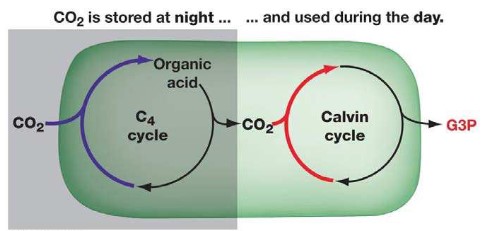Topic 9: Plant biology (HL)
9.1 Transport in the xylem of plants
Water properties:
- Cohesion: like molecules attract to each other
- Water is a polar molecule that forms a hydrogen bond with other water molecules.
- The negatively charged oxygen atom of one water molecule forms a hydrogen bond with a positively charged hydrogen atom of another water molecule.
- This attractive force between these molecules is called cohesion which helps plants draw water from the root through the xylem to the leaf
- Adhesion: unlike molecules attract to each other
- Capillary action may occur: water will move up the capillary due to the interaction between water molecules and capillaries
Transpiration:
- Evaporation occurs when some of the light energy absorbed by the leaf is converted to heat, thereby raising the temperature inside the leaf changing the water into water vapour.
- Transpiration is the evaporation of water from the leaves, stems and flowers. It is the movement of water vapour out of the leaf through stomata.
- The majority of water lost during transpiration is through openings on the bottom of the leaves called stomata.
- Transpirational pull results when water evaporates from the leaves and stems. More water is drawn up through the plant to replace the water that is lost.
- The loss of water generates a negative pressure and a transpirational pull on water molecules in the xylem.
- Transpirational pull results from the combined forces of cohesion and adhesion
- Water moves into the roots by osmosis through the cell walls and through the cytoplasm because the concentration of solutes inside the cells is greater than outside the root cells due to active transport of mineral and ions
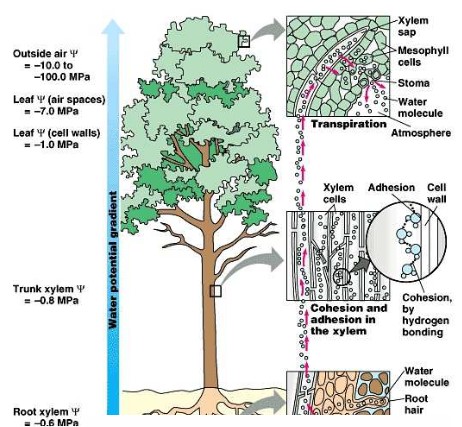
Structure of xylem:
- Xylem vessels are transport tissue found in vascular plants composed of a number of different types of cell, including long, continuous, thin, usually dead cells.
- Cell walls are thickened to make the xylem vessels stronger.
- The walls of the xylem are thickened and strengthened by a polymer called lignin
- Lignin may be deposited in different ways such as rings or spirals
- Since atmospheric pressure is greater than the pressure inside the xylem vessels, the ridged structure prevent them from collapsing
- The xylem is responsible for the transport of water and soluble mineral nutrients from the roots to the different parts of the plants that use water.
- This also allows minerals absorbed from the soil to be transported through the xylem to the leaves.
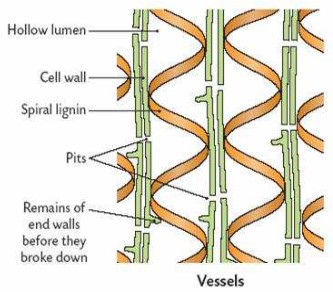
Active uptake of mineral ions:
- If the mineral ion concentration of a certain ion is greater inside the root cell than the surrounding soil, mineral ions have to be actively transported out of the root cell.
- Also the charged particles cannot directly cross the cell membrane because of the non-polar region inside the bilayer.
- Proton pumps use energy (ATP) to pump protons (H+) out of the root cell into the surrounding soil.
• This results in a higher concentration of protons outside the root cells creating an electrochemical and concentration gradient. - \(H^+\) can combine with sucrose, \(NO_3^-\), \(PO_4^{3}\), and other anions to bring them back into the root cell through protein channels, following the concentration gradient established by the proton pumps.
- \(K^+\) ions can flow directly through special channels following the electrochemical gradient created by the proton pumps.
- Cations such as potassium can also enter the root cell through specialized potassium pumps that use ATP to pump \(K^+\)directly into the cell.
- Since there is a greater concentration of ions or solutes inside the root cells, water will move into the root cells by osmosis
- Active uptake of mineral ions results in a higher concentration of minerals inside the root cells, thereby transporting water into the root cell by osmosis
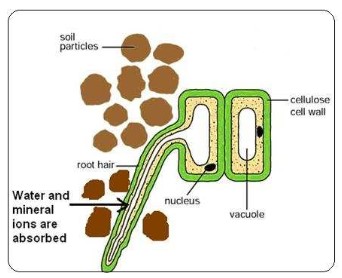
Xerophytes:
- Xerophytes are plants can survive in dry condition by reducing transpiration (water loss).
- Reduced leaves: conifers have needles and cacti have spines.
This decreases the surface area available for transpiration, thus decreasing water loss. - Rolled leaves: Stomata exist inside of rolled leaves. This creates local humidity within the rolled leaf, thus decreasing the leaf’s exposure to air currents because water vapour evaporates into the small air space inside the rolled leaf rather than atmosphere. This decreases water loss through transpiration.
- Reduced number of stomata: Some xerophytes have a reduced number of stomata. By reducing the number of stomata, water loss through transpiration is decreased because there are fewer holes for evaporation to take place.
- Thickened waxy cuticle: Thick waxy cuticle makes the leaves and in some cases stems, more waterproof and impermeable to water. This prevents water loss through the epidermal cells.
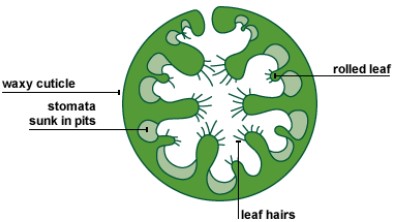
CAM plants (Crassulacean acid metabolism):
- \(CO_2\) is absorbed at night and store as \(C_4\)compound
- During the day, photosynthesis can occur with stomata closed by using carbon storage\(C_4\)
- It can minimize the time period which stomata opens and loses water to surroundings
